Agree, corn is not a very familiar cereal on the Russian table, which N. tried to plant with. Khrushchev after his visit to the USA. It didn’t work out very well - it’s a little cold for us.
I am cereal and margarine, I am flour and gelatin, rubber and acetone, and triple cologne.
I am rubber and asbestos, film, mayonnaise, I am viscose and starch, and any material.
So sang "Queen of the Fields" in a ditty from the Soviet cartoon from the time of N. s. Khrushchev.
Coupletists P. Rudakov and V. Nechaev sang: "A train with a load was going to Voronezh and fell down a slope. To harvest corn, someone took away all the rails." Such a case really took place in 1960 near Voronezh. First Secretary of the Voronezh Regional Committee of the CPSU a. M. schoolchildren ordered the directors of farms to show N. s. Khrushchev, as if harvesting was in full swing, and corn was crushed by rails that were dragged through the fields.
In culture, the genus is represented by the only species of Zea Mays, cultivated on an industrial scale and is a food, fodder and industrial crop. Growing corn is easy enough, and just one ear can fill you up for a whole day. Almost all over the world this cereal is called maize. We know it exactly as corn. In the US, maize is one of the main crops. There's a saying: "Corn is the Glue That Holds a Diverse Nation Like the Americans Together."
Actually, only 1% of the maize grown in the country goes to food in America. 85% of it is consumed by cattle and pigs - and it is thanks to this cereal that the meat - the US dairy industry ranks first in the world. And from the remaining 14% of maize, various food products and non-food products are produced - from corn whiskey to toothpaste. Glue, paste, plaster, and industrial water filters can also be made from corn.
But… it takes a sentient being to breed corn. This plant is not produced by self-sowing. Cobs, falling, rot. There are no wild ancestors of corn on Earth. Nobel Prize winner in Physiology or Medicine (1958), American geneticist D. beadle discovered that a strange genetic cocktail was mixed in this plant. And it is impossible to find the exact progenitor of corn on planet earth. It simply does not exist, although as a result of research it was even possible to determine the alleged place where corn began to spread - this is the Mexican state of puebla.
Paranormal investigators claim that such properties of this cereal can only be explained by its alien origin. According to myths, a very long time ago this cereal was given to people by creatures descended from heaven, whom earthlings considered gods. During archaeological excavations in Mexico, corn pollen was found, which is 55 thousand years old! I note that according to modern ideas, a reasonable person is about 40 thousand years old.
Astrologer R. Rodriguez: "The most ordinary corn is the most important confirmation that humanity has an alien origin. For corn to multiply, caring human hands are needed. Let's say rice or wheat can grow by itself - their seeds will be spread by animals. But corn itself ", without human intervention, is not capable of reproduction. Corn is a gift that the god Quetzalcoatl, as the Aztecs called him, made to mankind. Moreover, according to legend, it was from corn that man was created. " The ancient Indians portrayed the god of fertility, rain and harvest with a corncob in their hands.
Corn, whose beneficial properties were noticed in antiquity, not only tastes good. It is able to improve the body and solve a lot of health problems:
- digestion improves, bowel function normalizes, putrefactive flora is inhibited;
- visual acuity increases, the functions of the visual apparatus are restored;
- the work of the heart is normalized, the walls of blood vessels are strengthened, the risk of blood clots and cardiac diseases is reduced;
- depressions, neuroses are prevented, resistance to stress increases;
- immunity is strengthened, the frequency of colds is reduced;
- the quality of sleep improves;
- increases resistance to the development of cancer;
- accelerates the process of recovery of the body after increased stress, exhaustion, intoxication;
- the functional state of the mucous membranes is restored;
- the work of the reproductive organs of women and men returns to normal: the negative manifestations of menopause are weakened, the menstrual cycle is restored, potency increases;
- topical application of cornmeal helps to solve the problem of acne.
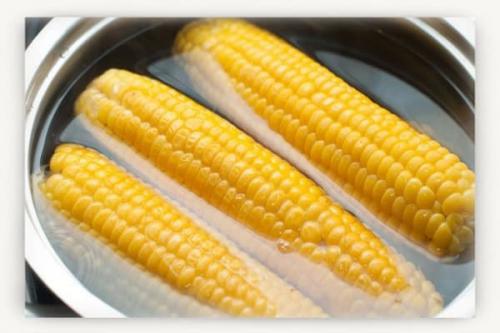
Vitamins and minerals contained in corn determine the benefits of grains for the human body. The cereal is eaten boiled, pressed for oil, canned, ground into flour and grits, baked, grilled and popcorn is prepared.
However, nutrition experts say: the less processed corn on the cob, the more beneficial it is for the body. Steamed cereal retains more vitamins. The calorie content of this dish is much lower than that of porridge, cereal or cereal bread.
However, there are a number of features of corn that make it potentially unhealthy:
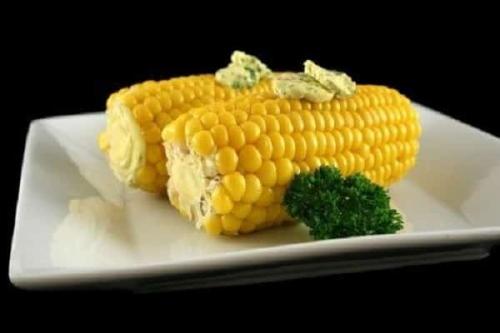
- cereal protein can provoke an allergic reaction;
- sugars contained in large quantities often cause bloating, flatulence and diarrhea;
- coarse fiber irritates the walls of the stomach and duodenum, which is unacceptable with an exacerbated ulcer;
- calcium in grains increases blood clotting, so the product should be limited in case of thrombosis or a tendency to thrombophlebitis;
- high calorie content of corn oil can cause obesity;
- the abundant consumption of this cereal by a nursing woman can cause colic in a child.
Therefore, if there are contraindications, you should limit the use or completely exclude corn from the diet.
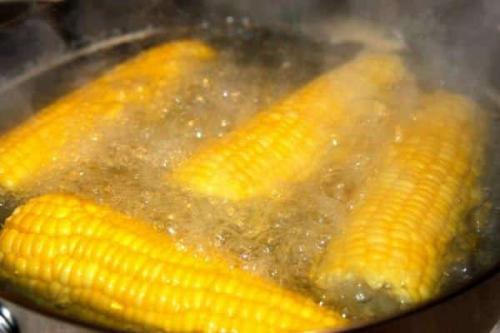
Where did corn come from on our planet. How did corn appear on Earth?
Agree, not a very familiar cereal on the Russian table, which N.S. Khrushchev tried to plant after his visit to the United States. It didn’t work out very well - it’s a bit cold for us corn.
In our folklore, it is reflected as follows:
I am a bread culture, I am a consumer culture.
I am cereal and margarine, I am flour and gelatin,
Rubber and acetone and triple cologne.
I am rubber and asbestos, film, mayonnaise,
I am viscose and starch, and any material -
sang "Queen of the Fields" in a ditty from the Soviet cartoon from the time of N.S. Khrushchev.
Coupletists P. Rudakov and V. Nechaev sang: “A train with a load was going to Voronezh and fell down a slope. For harvesting corn, someone took away all the rails. Such a case really took place in the 1960s near Voronezh. First Secretary of the Voronezh Regional Committee of the CPSU A.M. Shkolnikov ordered the farm directors to show N.S. Khrushchev, as if harvesting was in full swing and the rails that were treading through the fields were crushing corn.
In culture, the genus is represented by the only species of Zea mays cultivated on an industrial scale and is a food, fodder and industrial crop. Growing corn is easy enough, and just one ear can fill you up for a whole day. Almost all over the world this cereal is called maize. We know it as corn. In the United States, maize is one of the main crops. There is a saying: “Corn is the glue that holds together a diverse nation like the Americans.”
Actually, only 1% of the maize grown in the country goes to food in America. 85% of it is consumed by cattle and pigs - and it is thanks to this cereal that the US meat and dairy industry ranks first in the world. And from the remaining 14% of maize, various food and non-food products are produced - from corn whiskey to toothpaste. Glue, paste, plaster, and industrial water filters can also be made from corn.
But... You need an intelligent being to breed corn. This plant is not produced by self-sowing. Cobs, falling, rot. There are no wild ancestors of corn on Earth. Nobel Prize winner in Physiology or Medicine (1958), American geneticist D. Beadle discovered that a strange genetic cocktail was mixed in this plant. And it is impossible to find the exact progenitor on planet Earth. It simply does not exist, although as a result it was even possible to determine the alleged place where corn began to spread - this is the Mexican state of Puebla.
Paranormal researchers argue that such properties of this cereal can only be explained by its alien origin. According to myths, a very long time ago this cereal was given to people by creatures descended from heaven, whom earthlings considered gods. During archaeological excavations in Mexico, corn pollen was found, which is 55 thousand years old! I note that according to modern ideas, a reasonable person is about 40 thousand years old.
Astrologer R. Rodriguez: “The most ordinary corn is the most important confirmation that humanity has an alien origin. For corn to multiply, caring human hands are needed. Let's say rice or wheat can grow by itself - their seeds will be spread by animals. But corn itself, without the fate of man, is not capable of reproduction. Corn is a gift given to humanity by the god Quetzalcoatl, as the Aztecs called him. Moreover, according to legend, it was from corn that man was created. The ancient Indians portrayed the god of fertility, rain and harvest with a corncob in their hands.
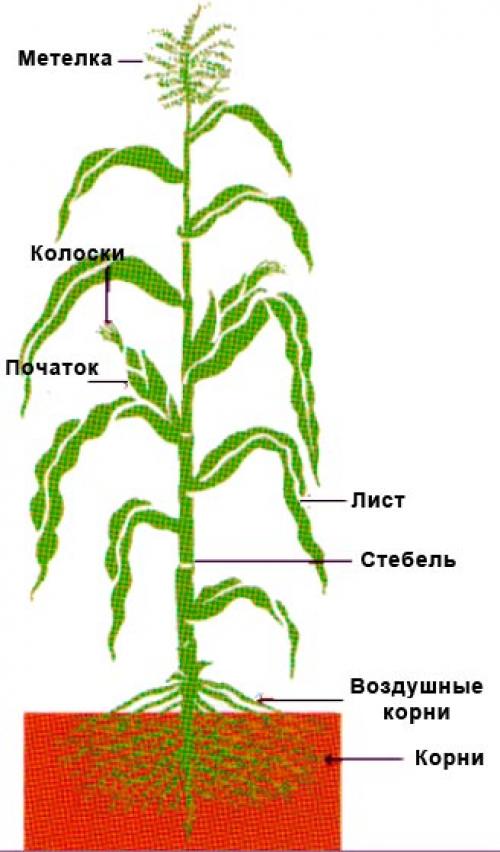
Maize is a monocotyledonous, annual herbaceous plant of the grass family (Gramíneae). Its botanical name is Zea mays L.
Corn root is fibrous, well developed. The bulk of the root system is made up of additional roots that come out of the underground nodes of the stem. So-called aerial or supporting roots depart from the first above-ground nodes, which help to increase the wind resistance of plants.
The corn stalk is cylindrical, without a cavity inside, straight, high (from 0.5 to 5 m or more); In low above-ground nodes of the stem, lateral shoots (stepchildren) are sometimes formed.
Corn leaves are linear-lanceolate, ciliate along the edge, pubescent on the upper side. They depart one by one from each node, alternately from one side of the stem, then from the other. The leaf consists of a sheath that emerges from the node and covers the entire lower and middle parts of the internode, the leaf blade, and a small tongue between the sheath and the leaf blade. The number of leaves and nodes on the main stem in different varieties is not the same (from 8 to 20 or more). As a rule, early-ripening varieties and hybrids of corn have fewer leaves than late-ripening ones.
Flowers in corn are dioecious: males have only stamens, and females have pistils. Male and female flowers are on the same plant, but are collected in separate inflorescences: male - in panicles that develop at the top of the stem, female - in cobs that emerge from the leaf axil from the stem node, so corn is a monoecious plant. Male inflorescences bloom 2-4 days earlier than female ones.
The panicle has a stem, a central axis and lateral branches, on which paired two-flowered spikelets are placed; one of them is sitting, the second is on a leg. The shape of the panicle, its size and the number of lateral branches in varieties of self-pollinated lines and hybrids are different.
The cob of corn is mainly cone-shaped or cylindrical in shape, located on a stalk, from the approximate internodes of which modified leaves extend, forming the wrapper of the cob. Spikelets with female flowers are placed in pairs in vertical rows on its stem in small cells. Two female flowers are laid in each spikelet, but only one of them develops, therefore there is always an even number of rows of grains in the cob.
The number of cobs on the plant, the height of their attachment, the length of the stalk, the number of rows at the beginning and the grains in the row, the graininess of the top, the width of the grooves between the rows, as well as the size of the grain depend on the characteristics of the variety or hybrid and the conditions for growing corn.
The fruit is a grain. The thin seed is tightly fused with the seed. The fruit consists of a shell, endosperm and embryo. The grains of different varieties differ in size, shape, texture, color and chemical composition.
Botanical characteristics of corn
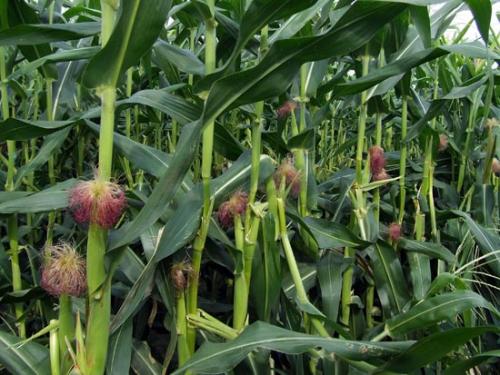
Corn
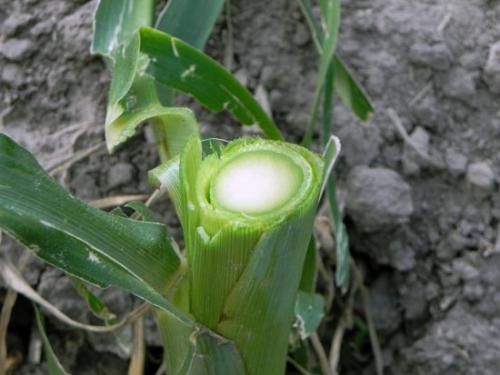
stalk of corn
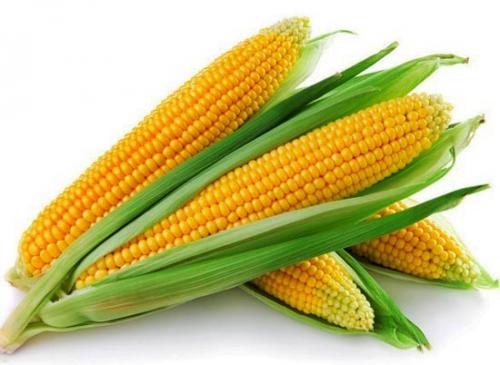
Corn cultivation. We provide the best conditions for corn
That is why growing corn in the country is becoming the only acceptable option for those who love natural products and care about their health. By growing this unpretentious plant on your site, you will not only get tasty and healthy corn grains, but you will also be able to collect corn stigmas, which are recommended for the treatment of the liver in folk medicine, and at the same time decorate the territory with tall showy plants with bright green foliage.
It remains only to figure out how to grow corn in the country in order to get high-quality cobs. Regular watering alone will not be enough to achieve the desired result. It is also necessary to take into account which neighbors you can plant corn next to, when to plant, and how to take care of the plants in the future.
Since the main areas where corn is grown on an industrial scale are located in the south of the country, many Russians have the opinion that this herbaceous crop grows well only in warm climates. However, a temperate climate is also quite suitable for its cultivation, if only the soil is slightly acidic and well fertilized. Land for planting corn should be prepared in the fall, especially if you are interested in growing early corn. Choose a place on the site so that it is well protected from cold winds, dig up the soil and immediately apply phosphorus and organic fertilizers to it.
For soil with high acidity, lime will also be required. You can grow corn in the country next to cucumbers, tomatoes, pumpkins, beans and beans. The most successful will be the neighborhood with a pumpkin, whose extensive leaves protect the roots of corn from weeds and overheating, as well as beans, which saturate the soil with nitrogen, and for beans, corn will do a good job in the form of a convenient support for weaving. It is not recommended to only plant corn next to celery or table beets.
How many calories are in boiled baby corn?
Calorie boiled corn Calorie boiled corn is 123 kcal per 100 grams of product.
Corn can be grown on your own, as well as purchased at a store or market. When buying cereal, you need to be careful. Sellers may pass off cheaper fodder varieties as edible crops. The taste of such cobs is rough and fresh. You can tell them apart by color. Cobs of fodder varieties have a rich yellow color.
Sometimes a good cob looks bright. A small test will help determine the quality. If you pierce a grain with a fingernail, then juice will spurt out of a good cob.
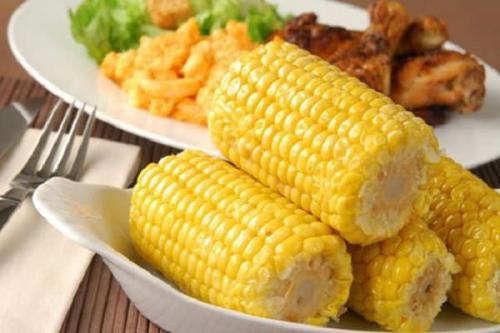
Corn is called (names, called) a useful cereal. However, a spoiled or old cob will not bring any benefit. When choosing a cereal, try to expand the cob. In a young plant, the grains are milky or light yellow in color, and the antennae are white and soft. The combination of white and yellow corn kernels in one cob signals that the cereal is still immature.
Dry leaves signal that the ear was cut long ago and has already lost its juiciness. If there are bugs and other insects under the leaves, then it is better not to buy such products.
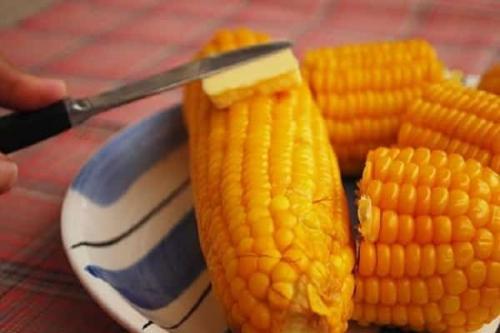
For many years, experts have been arguing about where this yellow miracle came from on our earth ?! There is even a version that corn is of alien origin and is a gift from an extraterrestrial civilization to all mankind.
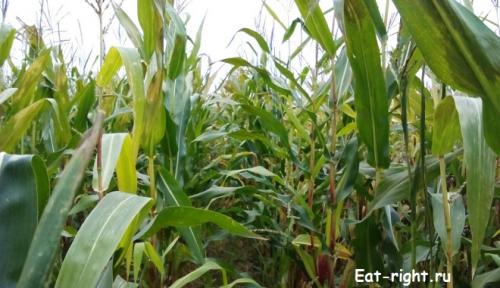
And this version appeared for the following reason: in many sources you can find information that no one has ever seen corn, or as it is also called maize, reproduce on its own! Those. such a process as the ripening of seeds and their dispersal is not at all characteristic of corn. Instead, mature cobs, if not removed in time, will simply fall to the ground and rot over time! Those. the plant is not capable of reproducing its own kind ...
But when I began to study information about corn on several forums, I met reviews of people who said that they had seen cases when corn sprouted on its own. But for this, the corn cob must be mature. And its shell should not be so tightly folded and begin to move away from the cob.
But in order to draw any conclusions, it is also necessary to tell you, friends, that corn still has wild counterparts. A huge number of different studies (including genetic ones) have confirmed this. So, the closest relatives of modern common corn are:
1. Small wild genus Tripsacum
2. Annual plant Teosinte - Zea Mexieana
3. Perennial Teosinte - Zea Perennis and Zea Diploperennis
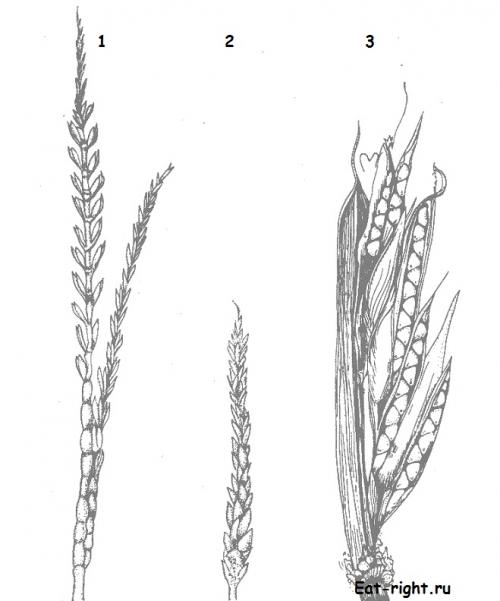
Note that all the plants presented are very similar in appearance to cereals in the traditional form in which we are accustomed to seeing them. And we are used to the fact that the inflorescences of cereals are presented in the form of panicles, brushes, heads or complex ears. And in modern corn, despite the fact that it is also a cereal, the inflorescence is represented by an ear to which the grains are firmly attached and all this is firmly protected by leaf wrappers. All these moments have been naturally selected and artificially bred by man over many decades to increase productivity and ease of processing and harvesting corn.
Now everything has fallen into place: corn has nothing to do with alien races, and all problems with the self-reproduction of corn are connected only with human activity and convenience.
P.S. By the way, the saying “corn is the queen of the fields” has gone since the reign of N.S. Khrushchev, who in 1955, with the mood of an absolute fanatic, ordered to sow almost the entire land of the Soviet Union with corn. After that, for several years, the area under corn only increased.
Corn (Zea Mays) currently makes up about 21 percent of the human diet worldwide.
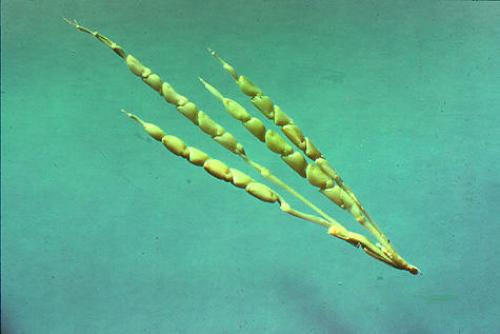
Teosinte has such a hard seed coat that it protects them from digestion in the digestive system of ruminants.
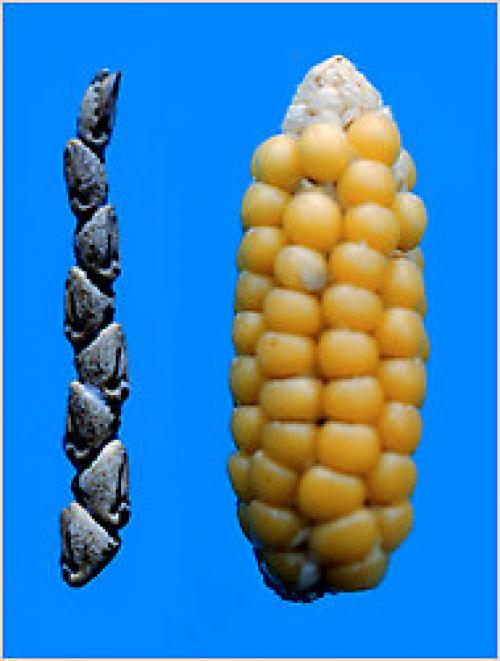
Seeds will remain viable after passing through the stomach of animals. Moreover, this is how the plant spreads through animal droppings.
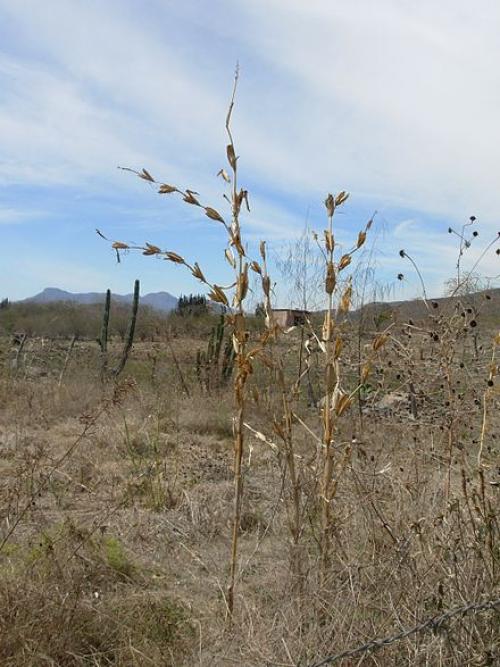
If you collect seeds from a plant, then in order for them to germinate, you will have to stratify them, for example, by immersing them in a solution of hydrogen peroxide.
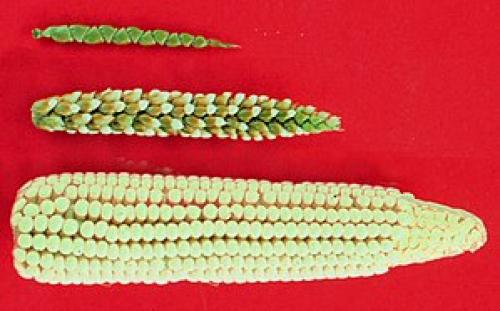
In the wild, plants are becoming less and less. Mexican officials and the Nicaraguan government have taken steps in recent years to protect wild teosinte populations.
By calculation, the genetic distance between modern corn and the teosinte plant was determined. This distance turned out to be very close to 9000 years. It is believed that it was then that the domestication of teosinte occurred.
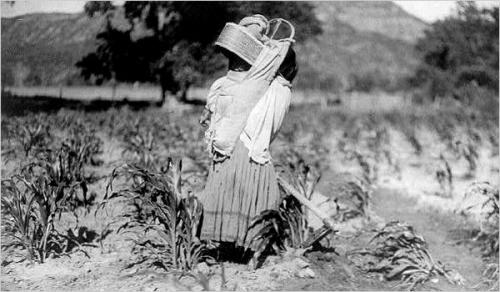
The researcher George W. Beadle, who hypothesized Teosinte, received the Nobel Prize in 1958 for his total merits.
Later in his career, Beadle crossed corn and teosinte, then crossed the hybrids together. About 50,000 plants were grown. He ended up with plants resembling teosinte and corn with such frequency that it became clear that only four or five genes controlled the major differences between the two species.
Where does corn come from in Russia?
Corn in Russia at first was called Turkish wheat. As a result of the completion of the Russian-Turkish war of 1806-1812. Under the Bucharest peace treaty, Bessarabia was returned to Russia, where corn was cultivated everywhere. From Bessarabia, corn spread to Ukraine.
